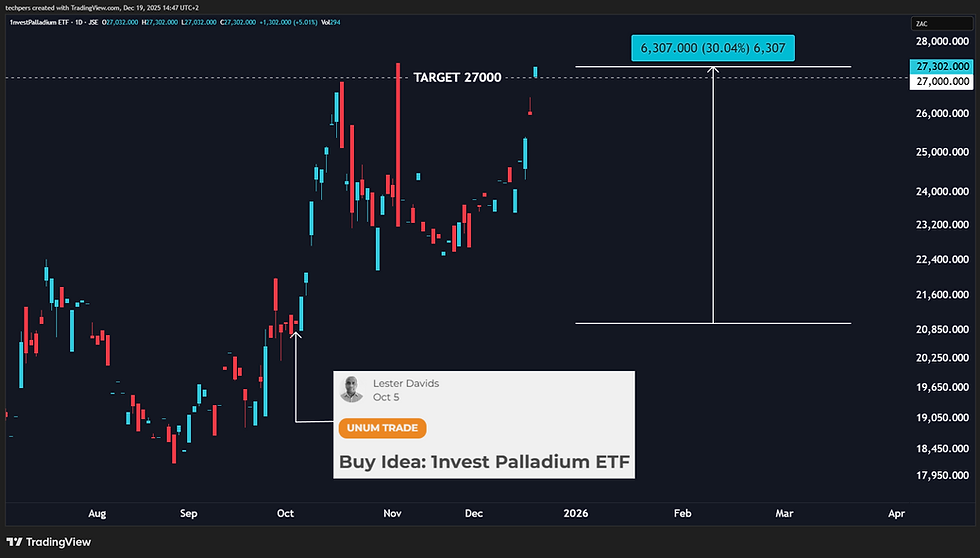Global Ideas: Trading Shell Plc - Strong Bull Trend Nearing Exhaustion
- Lester Davids

- Jun 23
- 3 min read
Research Notes For 23 to 27 June > https://www.unum.capital/post/r2327june
Trade Local & Global Financial Markets with Unum Capital.
To get started, email tradingdesk@unum.co.za
Strong Bull Trend Nearing Exhaustion
Shell PLC (SHEL) is currently in a strong bullish regime, with technical analysis confirming that buyers are firmly in control across all meaningful timeframes. The stock is attempting to advance and has demonstrated consistently positive momentum.

However, the recent aggressive rally has pushed the stock into a short-term state that is "Approaching Overbought." This condition, characterized by high bullish momentum on the 7-day trend, increases the probability of a pullback or consolidation phase. The model's consistent message across all timeframes is to avoid chasing the stock at these extended price levels. Instead, the primary strategy is one of patience, waiting for a healthy consolidation or a dip to key short-term moving averages (the 8 or 21-day EMA) to find a more favorable, lower-risk entry point to participate in the prevailing uptrend. This is a classic "buy the dip" scenario, not a "buy the breakout" setup.

2. Visualizing the Bullish Setup
The technical outlook points to a primary uptrend that is currently extended. The optimal bullish setup is not to buy at current levels, but rather to wait for a price retracement.
Primary Scenario: The price pulls back from its current highs toward the key short-term support zone, which is defined by the 8-day and 21-day Exponential Moving Averages (EMAs).
Entry Trigger: A long position would be triggered if the stock finds support in this zone and then demonstrates renewed strength, confirming that buyers are re-engaging after the pullback.
Target: The subsequent move would be expected to target and potentially exceed the prior highs.
3. Energy Sector: Fundamental Catalysts
The performance of Shell is heavily influenced by the fundamental drivers affecting the broader energy sector.
3.1. Bullish Catalysts (Tailwinds):
Strong Energy Prices: Elevated oil and gas prices, which are currently supported by disciplined OPEC+ supply management and a significant geopolitical risk premium, directly boost revenue and profitability for major producers like Shell.
Shareholder Returns: Strong free cash flow, generated from high energy prices, allows the company to execute a robust capital return program. This includes aggressive share buybacks, which support the share price, and a reliable, growing dividend.
3.2. Bearish Catalysts (Headwinds):
Global Economic Slowdown: A major recession would lead to a significant decrease in global energy demand. This "demand destruction" would put severe downward pressure on oil and gas prices, directly impacting Shell's revenues and margins.
Energy Transition Risk: The long-term, secular global shift toward renewable energy sources and away from fossil fuels poses a structural headwind to the traditional oil and gas business model. This requires significant, ongoing investment in new technologies and creates uncertainty around the long-term value of legacy assets.
4. Dissecting the Price Action Model
The technical outlook for Shell is consistent across multiple timeframes, pointing to a strong trend that is due for a pause.
Short-Term (1-10 Days): The model indicates that buyers are in control, but there are signs of weakness on the lowest time frames. This suggests that a pullback is likely. The recommended strategy is to look for this pullback to the 8 or 21-EMA to establish a potential "buy range."
Medium-Term (2-4 Weeks): The view is of a steady upward trend. However, there is a possibility of sideways consolidation around the current levels as the market takes time to absorb the recent significant gains before the next move higher.
Long-Term (5-8 Weeks): The stock is attempting to advance within an established bullish regime. The model advises using pullbacks to the prior session's close or the 8-EMA as an "accumulation zone" for long-term positions.

5. Price Action Probabilities
Based on the current technical readings, the probabilities for the next major price move are assessed as follows:
Pullback then Continuation (65% Probability): This is the primary and most likely scenario. The "Approaching Overbought" condition resolves through a healthy and orderly pullback to the 8/21-EMA support zone. This retracement alleviates the overbought condition and provides a lower-risk entry point for the next leg higher, in line with the primary uptrend.
Sideways Consolidation (25% Probability): The stock moves sideways in a choppy range, absorbing the recent aggressive buying through time rather than through a significant price drop. The uptrend would be expected to continue after this consolidation phase.
Deeper Correction (10% Probability): This is the least likely scenario. In this case, the failure to hold the highs triggers a more significant correction that breaks below the key short-term moving average support levels, signaling a potential trend change.
Lester Davids
Senior Investment Analyst: Unum Capital




Comments